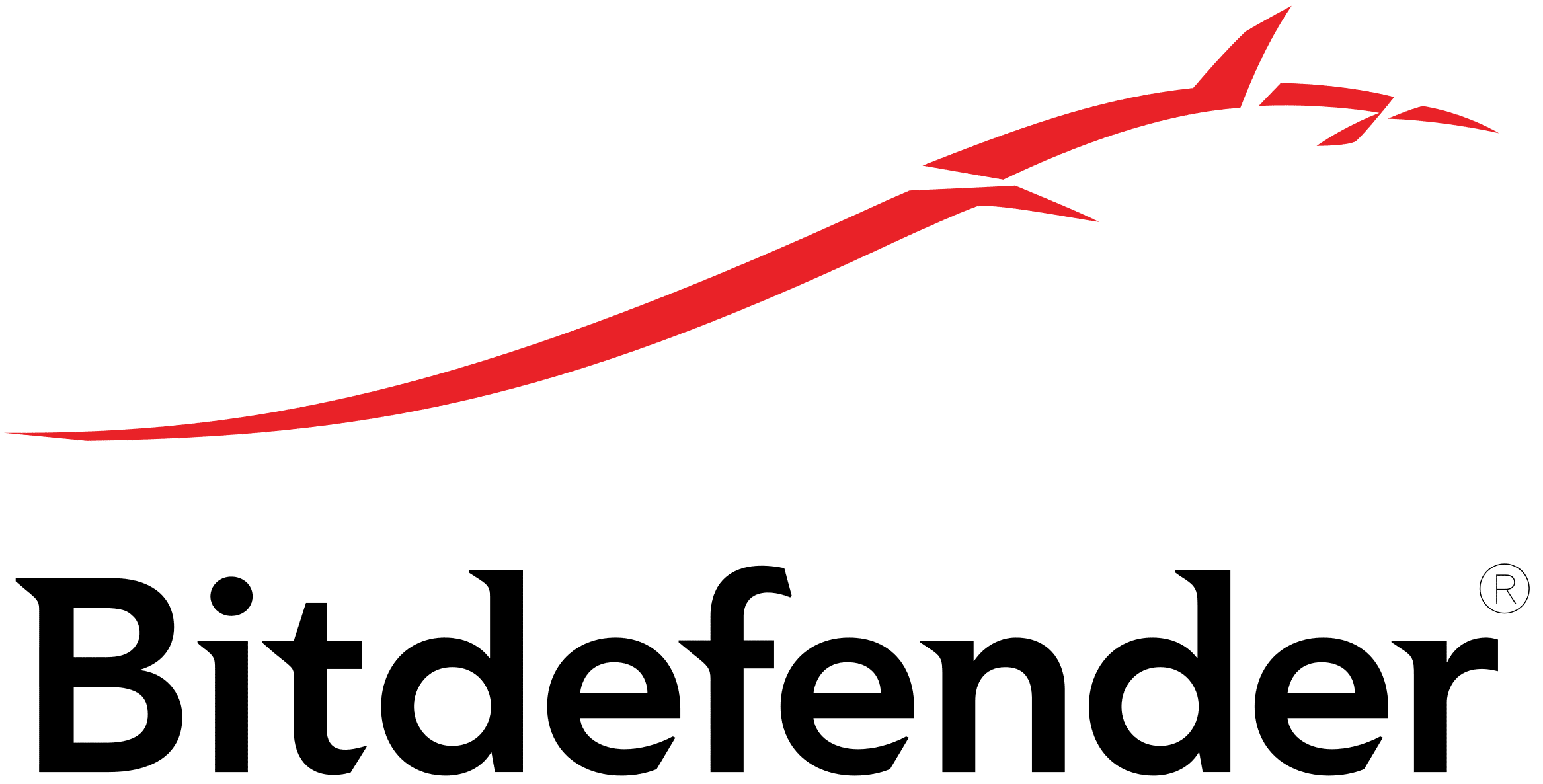Turn Your Tech Stack into a Security Engine
ORDR’s open platform supports 200+ integrations to unify data, automate policies, and enhance your existing tools, delivering faster time to value and more effective security actions.

Accruent
The bidirectional integration between Ordr and Accruent’s Connectiv combines the power of Ordr’s connected device security platform with Accruent’s healthcare CMMS software. The joint solution enables healthcare organizations to improve inventory management while reducing device security risk.
Once Ordr collects and consolidates asset information from Connectiv, it augments the CMMS with Ordr discovered assets, and enriches existing asset with granular profile data, vulnerabilities, risk context, and utilization details.
How it works
Once Ordr collects and consolidates asset information from Connectiv, it augments the CMMS with Ordr discovered assets, and enriches existing asset with granular profile data, vulnerabilities, risk context, and utilization details.
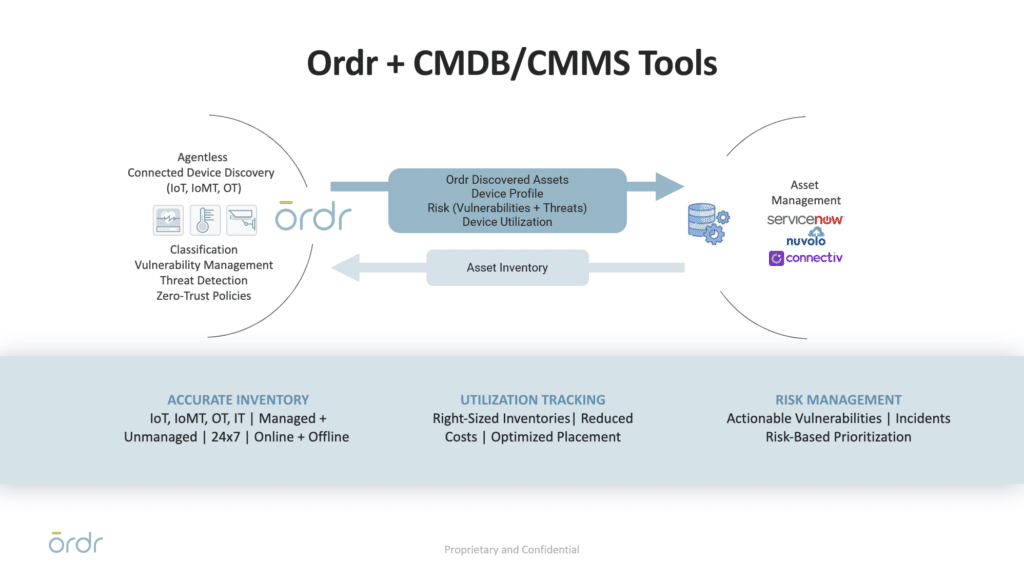
Benefits
- Accurate and streamlined inventory management: Automatically build and maintain a complete and accurate inventory of connected healthcare devices and eliminate manual inspection and software version record-keeping
- Optimize device utilization: Monitor core components of the medical device fleet to efficiently manage and understand medical device utilization data, right-size inventories, lower costs, and optimize placement.
- Risk management: Inform security operations on the precise nature of a vulnerability or threat, quickly identify any at-risk medical devices, and take proactive measures to mitigate risk.
Amazon Web Services
The increasing growth of cloud adoption adds a visibility black hole, making it difficult to fully understand how devices are connecting – and what those devices are actually communicating with in the cloud. This increases the risk factors of connected devices exponentially.
Gaining visibility and control across an organization’s entire attack surface of connected assets is one of the most fundamentally important – yet challenging – tasks facing IT and security teams today.
How it works
Ordr gathers cloud asset information by collecting attributes from Amazon Elastic Compute Cloud (EC2), the AWS service used to create and run virtual machines.
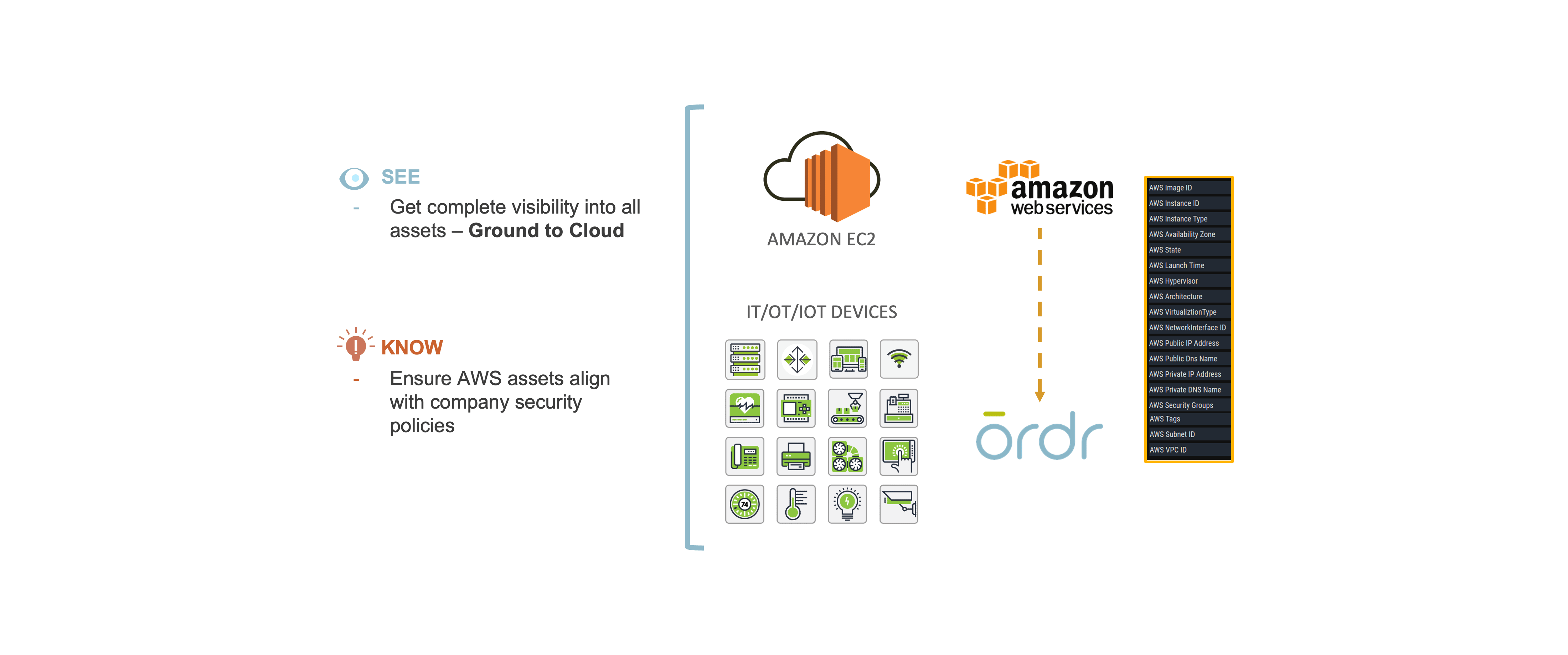
Benefits
Ordr integrates with Amazon Web Services (AWS) to deliver complete ground to cloud visibility– from assets in remote sites and campus devices, all the way to assets in the cloud.
- See: Get complete visibility into all assets- Ground to cloud
- Know: Ensure AWS assets align with company security policies
Anomali
Ordr’s ability to consume STIX and TAXII – and incorporate these threat feeds into the Ordr Data Lake – now extends this security strategy to the critical realm of agentless devices such as IoT, medical devices, smart office appliances, and operational technology, and more for deep understanding of devices, behaviors, and network intelligence to identify assets, alert on threats, and automate response actions.
Arista
Ordr integrates with wired and wireless infrastructure solutions to combine network details with granular device insights and ensure accurate device classification, location details, and anomaly detection.
How it works
Ordr analyzes collected data to enhance insights through passive discovery, accurately classifying each asset. By analyzing data from Arista switches, it maps communication flows, establishing normal behavior baselines for each device. These baselines are automatically fine-tuned, updated, and compared to historical behavior and similar devices. Ordr identifies anomalies in device behavior, comparing them to global deployments. This analysis enables incident response teams to swiftly pinpoint specific devices, locations, connections, and communication details, facilitating rapid threat response.
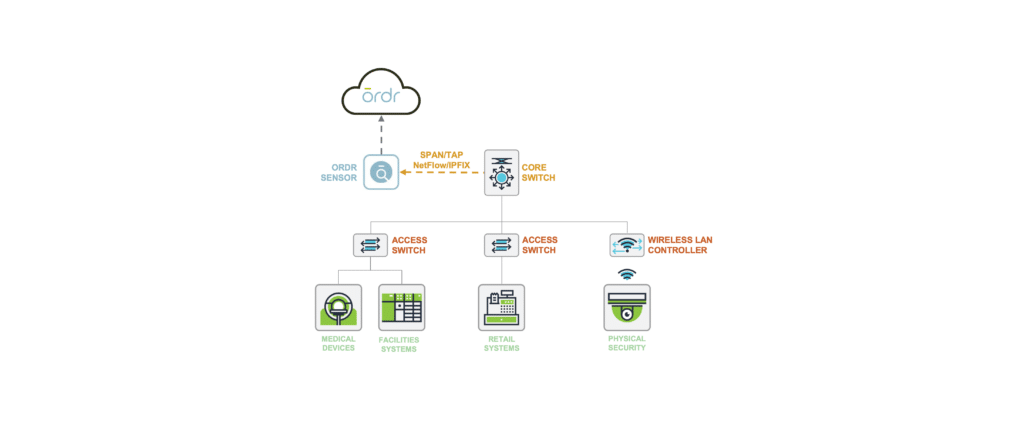
Benefits
- See every device connecting to the network
- Identify anomalous behavior
- Accelerate response to threats
Aruba
With Ordr and HPE Aruba ClearPass Policy Manager (CPPM), organizations can quickly gain complete visibility into every connected device and deploy segmentation to proactively protect and reactively respond and mitigate threats. This includes Zero Trust policy enforcement and microsegmentation to isolate groups or individual devices from non-essential access while protecting them from attack and compromise on existing networking and security infrastructure
How it works
The integrated Ordr SCE and HPE Aruba CPPM solution makes it easy to get rich visibility for IoT and unmanaged devices and to simplify segmentation projects. The solution provides detailed classification and context for every connected device, automatically groups devices into CPPM policy groups for role-based access and facilitates software-defined segmentation to provide more precise controls for every IoT device in the network. By providing continuous, multi-level security monitoring of all device communications, Ordr SCE detects anomalous behavior and shares this information with ClearPass to implement network access control based on vulnerability, threat, and risk ratings. Ordr SCE also integrates with HPE Aruba CPPM to streamline the process of containing threats based on the organization’s access policy such as blocking unauthorized devices, quarantining them, or limiting their network access.
Benefits
- Automating IoT inventory discovery, classification, and categorization, and sharing detailed device context with ClearPass
- Providing rich analytics about the behavior of all devices that guides segmentation design, streamlines the segmentation implementation, and audits the result to assure accuracy and effectiveness
- Quickly contain threats and protect at-risk devices
- Accelerating ClearPass deployments with powerful yet easy-to-use tools that provide accurate device information and automate steps that are traditionally error-prone and labor intensive
Avaya
Ordr integrates with Avaya (Extreme Networks) wired infrastructure to augment device profiles with network context, visualize communications and enforce policies.
BigFix
Ordr integrates with BigFix, an endpoint management platform built to discover, manage, and remediate all endpoints whether on-premises, mobile, virtual, or in the cloud – regardless of the operating system, location, or connectivity.
How it works
Ordr collects attributes for all BigFix managed devices and enables you to see and know more about all your devices, their connections, and vulnerabilities.

Benefits
- See Every Connected Device: Automate and centralize discovery of all managed, unmanaged and newly connected devices.
- Advanced Endpoint Profiling: Know more about devices by combining granular Ordr insights with BigFix endpoint data.
- Security Posture Compliance: Gain a comprehensive understanding of risk and generate compliance reports for all managed and unmanaged devices.
Bitdefender
Ordr integrates with Bitdefender to provide comprehensive visibility across all agent-based and agentless devices, and risk insights for proactive risk mitigation.
BlueCat
Ordr integrates with BlueCat to increase data accuracy for device analytics. Ordr collects IP address assignments to devices for accurate MAC-to-IP binding to ensure security alerts and flow data are always mapped to the correct endpoint.
BMC Helix
Ordr integration with BMC CMDB allows organizations to simplify inventory management and proactively mitigate asset risk
Brocade
Ordr integrates with Brocade wired infrastructure to augment device profiles with network context, visualize communications and enforce policies.
Check Point
Together, Ordr and Check Point allow you to Take Control of your IOT and OT security by implementing segmentation across your hyper-connected enterprise. Ordr integrates natively with Check Point Security Management for multi-gateway policy enforcement. When new devices are connected to the network, they are automatically classified and updated in Check Point Security Management and Security Gateways with the proper IoT Asset membership. Through its network and device awareness, Ordr maintains current IP addressing for IoT Assets in all Security Gateways.
How it works
Check Point Security Gateways provide scalable policy enforcement and zone controls for the enterprise. Ordr discovers, classifies and groups all devices and automatically maps them into their respective zones, areas, and cells using Check Point IoT Asset groups, and then dynamically generates Security Gateway policy rules based on these groups to deliver streamlined microsegmentation.
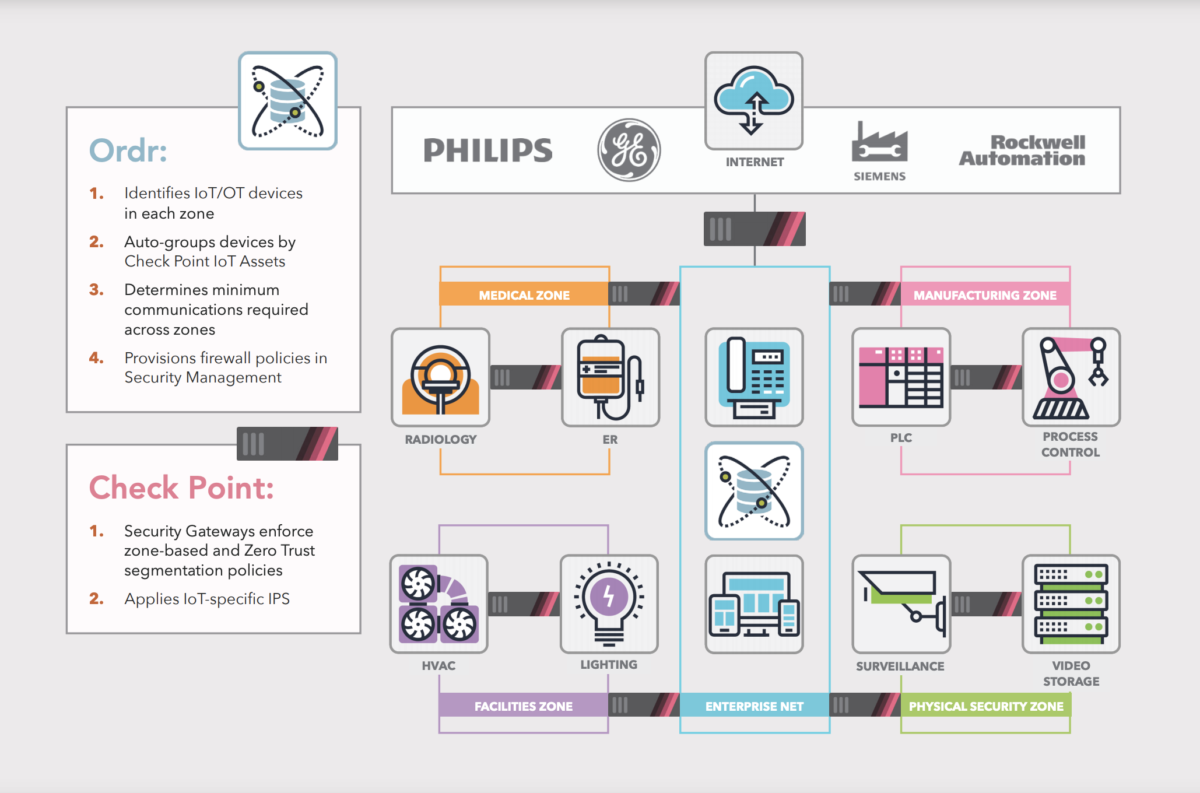
Benefits
- Take Control of your IOT and OT security by implementing segmentation across your hyper-connected enterprise.
CrowdStrike
Integration between Ordr and CrowdStrike ensures the security of all managed and unmanaged devices with comprehensive device visibility, detailed vulnerability insights, an understanding of risk, and the ability to enforce policy to mitigate active threats and improve security across all connected devices
How it works
Ordr analyzes network flow data to automatically discover and classify every connected device, profile behavior, and identify active threats. Security telemetry from the CrowdStrike Falcon platform, is shared with Ordr to enhance device insights, and provide a centralized, deep understanding of each device and its associated risk. Ordr uses multiple factors to calculate risk for each device based on business context, asset criticality, vulnerabilities, and overall threat details. With additional device data from the Falcon platform, Ordr provides a highly accurate risk score for each device. By continuously synchronizing device risk scores with CrowdStrike’s enriched security data, Ordr enables teams with an up-to-date view of risk to help them focus on the most critical devices.
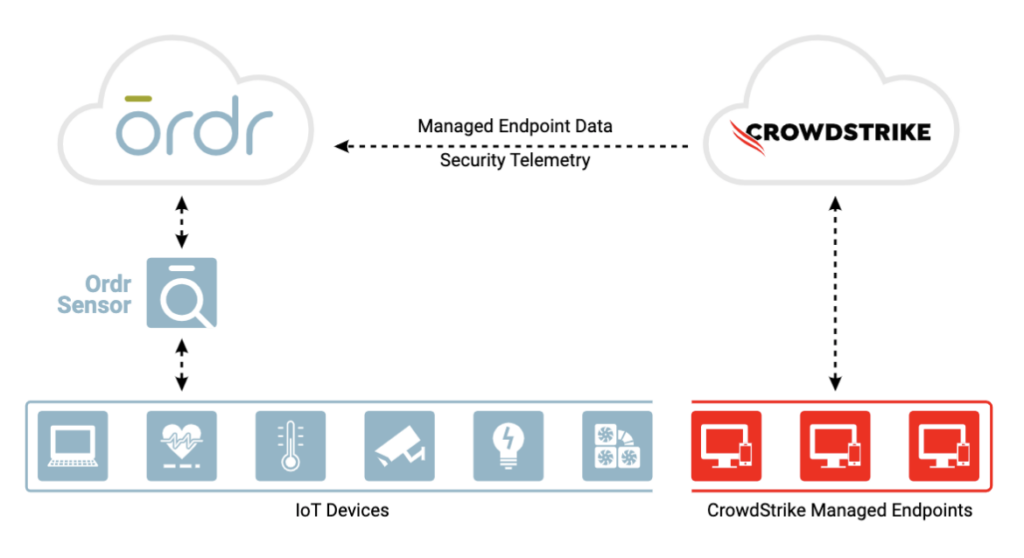
Benefits
Gain complete device visibility
- See into all devices – agentless and agent-based
- Track both online and offline devices continuously
- Identify unmanaged devices without CrowdStrike agent for compliance
Minimize risk with better insights
- Improve Ordr risk score accuracy with supplemental event data from CrowdStrike
Remediate faster
- Improve threat detection and incident response time with a combination of Ordr endpoint flow & CrowdStrike process data
- Block/quarantine/segment managed endpoints in Ordr for rapid remediation via the network
Dragos
Integration between ORDR and Dragos provides organizations with complete and granular IT, OT, and IoT visibility, transforming deep OT intelligence into automated network segmentation policies that enhance operational resilience and reduce cyber risk.
How it works
Through an API-based integration, the Dragos Platform shares enriched OT asset and vulnerability data with ORDR AI Protect Platform. This enables ORDR to automatically create, simulate, and enforce intelligent segmentation policies based on real-time device visibility and contextual risk.
By combining Dragos’s deep OT insight with ORDR’s automated AI-driven policy recommendations and enforcement, security teams can isolate legacy devices, restrict access to critical systems, and block risky protocols—all while maintaining uptime and compliance.
Benefits
Gain Unified Visibility
- Comprehensive and deep visibility across IT, OT, and IoT assets
- Continuous synchronization of Dragos-enriched OT data with ORDR
Enhance Security & Resilience
- AI-driven enforcement through existing network infrastructure
- OT-specific threat detection and contextual risk scoring
- Reduced downtime and faster response to incidents
Simplify Compliance
- Supports IEC 62443, NIST 800-82, and SANS ICS Critical Controls
Duo Security
Ordr integrates with Duo enabling organizations to seamlessly leverage their preferred user authentication method for secure access with an extra layer of protection.
e-Quip
Ordr and e-Quip provide real-time insights and detailed information to manage and secure the increasing number of connected medical devices
Elastic
Ordr integration with Elastic allows SecOps teams to leverage Ordr’s rich device data to create alerts, reports, and custom analyses. Ordr transmits security alerts, device information, and other critical information. QRadar ingests the feed for improved event management.
Exabeam
Ordr’s ability to consume STIX and TAXII – and incorporate these threat feeds into the Ordr Data Lake – now extends this security strategy to the critical realm of agentless devices such as IoT, medical devices, smart office appliances, and operational technology, and more for deep understanding of devices, behaviors, and network intelligence to identify assets, alert on threats, and automate response actions.
Extreme
Ordr integrates with Extreme networking infrastructure to augment device profiles with network context, visualize communications and enforce policies.
Forescout
Ordr integrates with Forescout providing visibility into every connected device to enable rapid response to active threats, and simplify the creation of segmentation policies for improved security.
Fortinet
Fortinet and Ordr have partnered to deliver an industry-leading IoT and unmanaged device security solution by integrating FortiManager, FortiGate and FortiNAC with Ordr Systems Control Engine (SCE)
How it works
Automated Visibility and Security of All Connected Devices
Ordr SCE automatically creates a complete asset inventory, identifies and prioritizes asset risk, and tracks and risk-rates asset communications patterns. Ordr transmits this critical security context to Fortinet FortiGate, FortiManager, and FortiNAC, allowing administrators to create and apply firewall and NAC policies using business-relevant groups, classifications, and device names, while understanding the full risk profile and impact of each change. Ordr further reduces administrative costs by automatically updating asset groupings as devices join and leave the network, as well as by creating and transmitting security policies directly to FortiGate and FortiManager for enforcement.
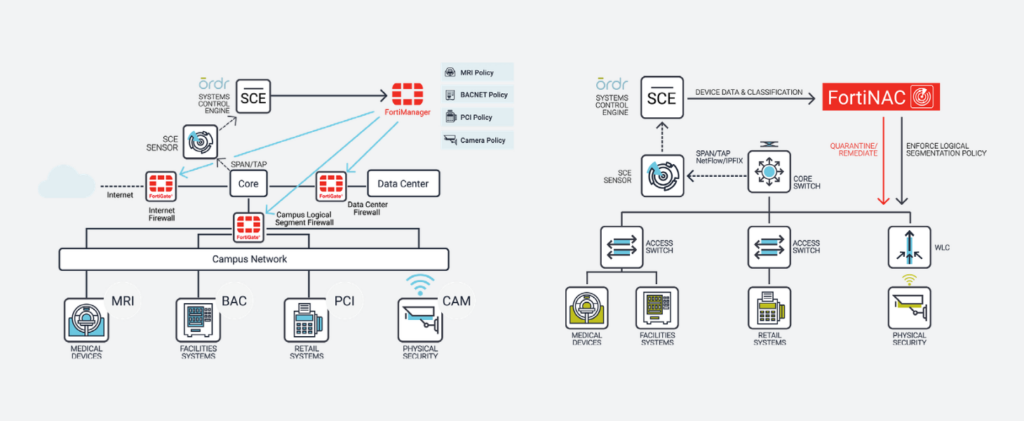
Benefits
With the integration, joint customers can now:
- Discover and inventory every connected network asset, including the massive volume of IoT and unmanaged devices, and make available across the Fortinet Security Fabric, from endpoint to edge, through FortiNAC, FortiManager, and FortiGate
- Establish comprehensive security controls that restrict IoT devices to known-good network behaviors
- Manage firewall and NAC policies using business-relevant context such as device type, manufacturer, location, risk, and function rather than IP addresses
- Automate updates of firewall groups and address info to ensure consistent policy enforcement regardless of device location, VLAN, or IP assignment, thus drastically reducing operational costs and downtime
- Protect critical devices with automated, zone-based segmentation and microsegmentation within zones
Freshdesk
Ordr integrates with Freshdesk to automate ticketing when a threat or incident is detected.
Gigamon
A basic tenet of network security and regulatory compliance is that “You cannot secure what you cannot see.” Gigamon and Ordr have teamed to deliver unsurpassed visibility and control into every thing connected to your network.
How It Works
The Gigamon Visibility and Analytics Fabric (VAF) optimizes data collection of all north-south and east-west traffic across branch, campus, data center and cloud. Collected data is delivered to Ordr for analysis to ensure comprehensive device classification and visibility into all device communications. Integration with Gigamon VAF also eliminates concerns of SPAN security and potential impact to network infrastructure with “yet another SPAN port or session.”
By integrating with Gigamon VAF, customers can significantly reduce the number of Ordr sensors required to comprehensively discover and monitor every network-connected device, simplifying your network and security monitoring architecture.
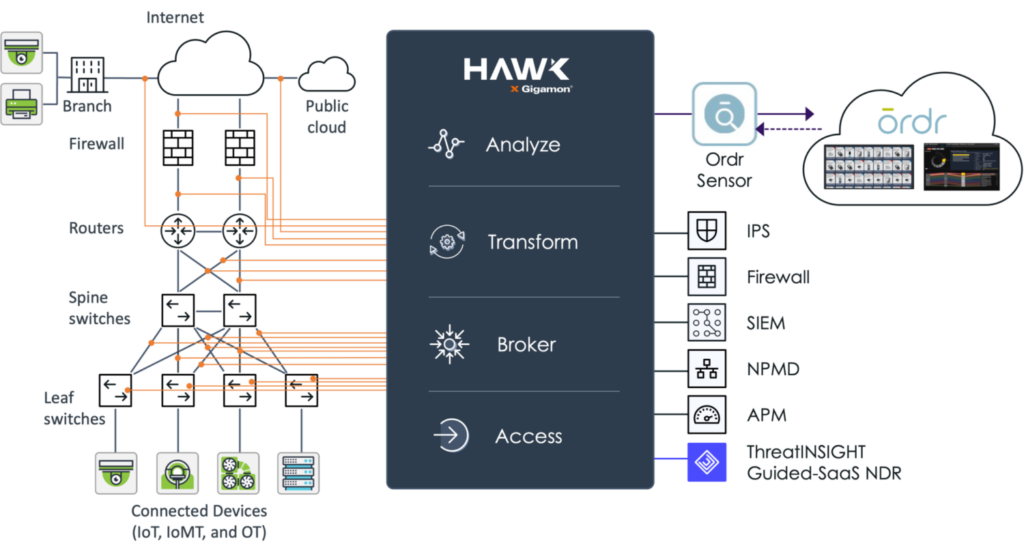
Benefits
- Real-time asset inventory – Ordr continuously analyzes device traffic sent from Gigamon to passively discover an automatically classify every device connected to the network to help you maintain an up-to-date and accurate inventory.
- Connected device risk – using the traffic captured and optimized by Gigamon Hawk, Ordr calculates device risk scores and uncovers connected devices with risk such as outdated operating systems, unpatched software, weak passwords, and manufacturer recalls. Ordr also maps and baselines device communications to identify risk and stop attacks.
- Accelerate Zero Trust – working together, Gigamon and Ordr can map and baseline all IT, IoT and other device communications. Ordr can then dynamically create Zero Trust policies to simplify and accelerate NAC and segmentation projects. These policies can be enforced with popular security and network devices to integrate with existing infrastructure tools.
Ordr integrates with Google Cloud Platform to extend visibility into cloud assets by collecting essential cloud instance attributes from Google Cloud.
Guardicore
Guardicore pulls Ordr’s device classification data and adds it to a granular map of the whole data center giving you a single view and the ability to segment unmanaged devices.
H3C
Ordr integrates with H3C wired infrastructure to augment device profiles with network context, visualize communications and enforce policies.
Hirschmann
Ordr integrates with Hirschmann wired infrastructure to augment device profiles with network context, visualize communications and enforce policies.
HPE
Ordr integrates with HPE networking infrastructure to augment device profiles with network context, visualize communications and enforce policies.
Huawei
Ordr integrates with Huawei wired infrastructure to augment device profiles with network context, visualize communications and enforce policies.
IBM QRadar
Ordr integration with QRadar allows SecOps teams to leverage Ordr’s rich device data to create alerts, reports, and custom analyses. Ordr transmits security alerts, device information, and other critical information . QRadar ingests the feed for improved event management.
Infoblox
Ordr integration with Infoblox increases data accuracy for core analytics. Ordr collects IP address assignments to devices for accurate MAC-to-IP binding to ensure security alerts and flow data are always mapped to the correct endpoint.
Ivanti
Ordr integration with Ivanti MDM allows organizations to leverage rich context from all mobile devices managed by Ivanti. Ordr collects device, user and installed app details enabling you to see and know more about all your devices, connections, and vulnerabilities.
Jamf
Ordr integrates with Jamf to extend visibility to all managed Apple endpoints and enrich the Ordr Data Lake with rich device context from the Jamf platform.
How it works
Ordr integration with Jamf enables organizations to extend visibility to all Jamf managed Apple devices. Ordr collects device, user, and installed application details to enrich the Ordr Data Lake and enhance the view of all devices, connections, and vulnerabilities.
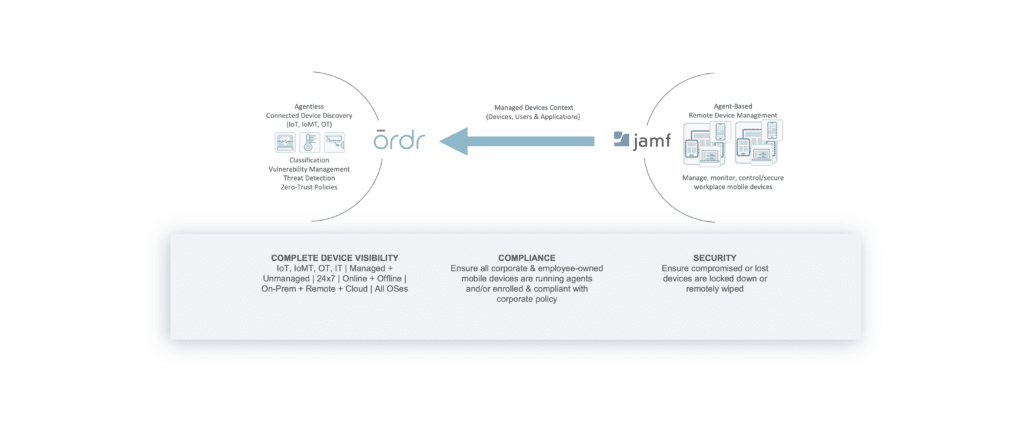
Benefits
- Real-time visibility of all connected devices across all operating systems, on-prem, remote, managed, and unmanaged.
- Comprehensive insights into vulnerabilities and risk prioritized to align with your organization.
- Centralization of the view for your connected device attack surface and risk posture.
- Acceleration of threat response and proactive Zero Trust security efforts with automated policy.
- Accurate and up-to-date device details to meet compliance and cyber insurance requirements.
Jira
Ordr integrates with Jira to automate ticketing when a threat or incident is detected.
Juniper
Ordr integrates with Juniper networking infrastructure to augment device profiles with network context, visualize communications and enforce policies.
Linux
Ordr integrates with Linux DHCP servers to increase data accuracy for device analytics. Ordr collects IP address assignments to devices for accurate MAC-to-IP binding to ensure security alerts and flow data are always mapped to the correct endpoint.
LogRhythm
Ordr integration with LogRhythm allows you to leverage Ordr’s rich device data to create alerts, reports, and custom analyses. Ordr transmits security alerts, device information, and other critical information via the Syslog output format. LogRhythm ingests the feed, parses the data into proper fields for better event management.
Medimizer
Ordr with Medimizer to simplify inventory management and add risk context to connected medical equipment.
Microsoft
Ordr integrates with multiple Microsoft solutions to enhance device context and improve risk insights to keep your organization secure.
Motorola
Ordr integrates with Motorola wireless infrastructure to augment device profiles with network context, visualize communications and enforce policies.
Netgear
Ordr integrates with Netgear wireless infrastructure to augment device profiles with network context, visualize communications and enforce policies.
Nuvolo
Ordr and Nuvolo have teamed up to create a healthcare partnership to reduce device cyber security risk. The solution combines Ordr’s superior IoT Security Platform to discover and profile connected devices in healthcare organizations with Nuvolo’s workplace management platform for healthcare.
The joint solution enables organizations to optimize their device utilization while significantly reducing risk and improving operational efficiency.
How it works
Ordr’s bidirectional integration with Nuvolo allows you to simplify inventory management and proactively mitigate risk. Ordr collects inventory data from Nuvolo and sends Ordr-discovered device data along with risk and utilization details for all devices.
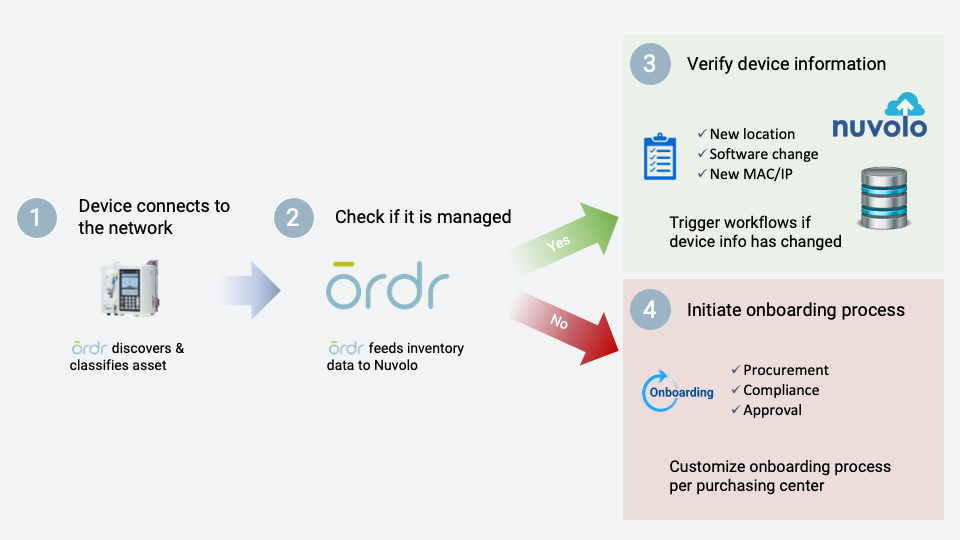
Benefits
- Streamline inventory management: automatically build and maintain a complete and accurate inventory of connected medical devices and eliminate the manual inspection and software version record-keeping
- Optimize device utilization: monitor core components of the medical device fleet to efficiently manage and understand medical device utilization data, right-size inventories, lower costs, and optimize placement.
- Risk management: inform security operations on the precise nature of a vulnerability or threat, quickly identify any at-risk medical devices, and take proactive measures to mitigate risk including implementing granular segmentation to protect devices
Okta
Enable Single Sign On (SSO) for Ordr with Okta.
Oracle
Enable Single Sign On (SSO) for Ordr with Oracle IDCS.
Osquery
Ordr integrates with Osquery by providing a custom query pack for collecting granular device data from devices running the open-source agent.
Gain visibility into all devices independent of operating system with support for Windows, macOS, CentOS, FreeBSD, and almost every Linux distribution.
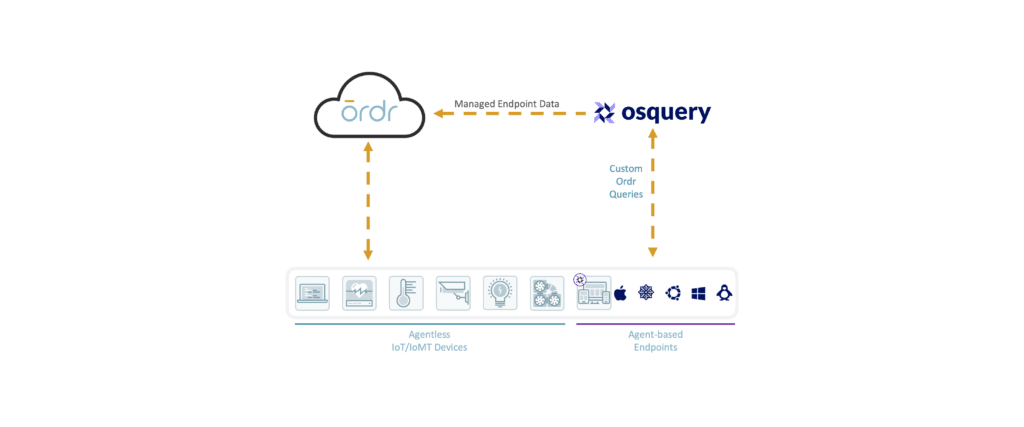
Palo Alto Networks
Palo Alto Networks and Ordr have joined forces to provide the most effective solution to identify, classify,
and protect IoT and digital OT devices from unauthorized access and cyberattack.
How it works
- Passively discovers every connected device with high-definition detail—without the use of agents
- Automatically classifies devices with tags and maintains membership
- Quickly spots vulnerable and compromised devices so they can be quarantined
- Rapidly implements zone-based segmentation per NIST and IEC 62443 with AI-created firewall policies
- Continuously monitors device security risk and behavior
- Verifies segmentation policy is effective using simple, graphical tools
Benefits
The most effective means to protect IoT and digital OT devices is through IEC microsegmentation and Zero Trust policy rules. Palo Alto Networks Next-Generation Firewalls (NGFWs) provide scalable policy enforcement and segmentation controls for the enterprise. OrdrAI Protect discovers, classifies and groups all devices and automatically maps them into their respective zones, areas, and cells using PAN-OS tags, and then dynamically generates NGFW security policy rules using these tags to deliver streamlined microsegmentation.
Download the complete solution brief for more details.
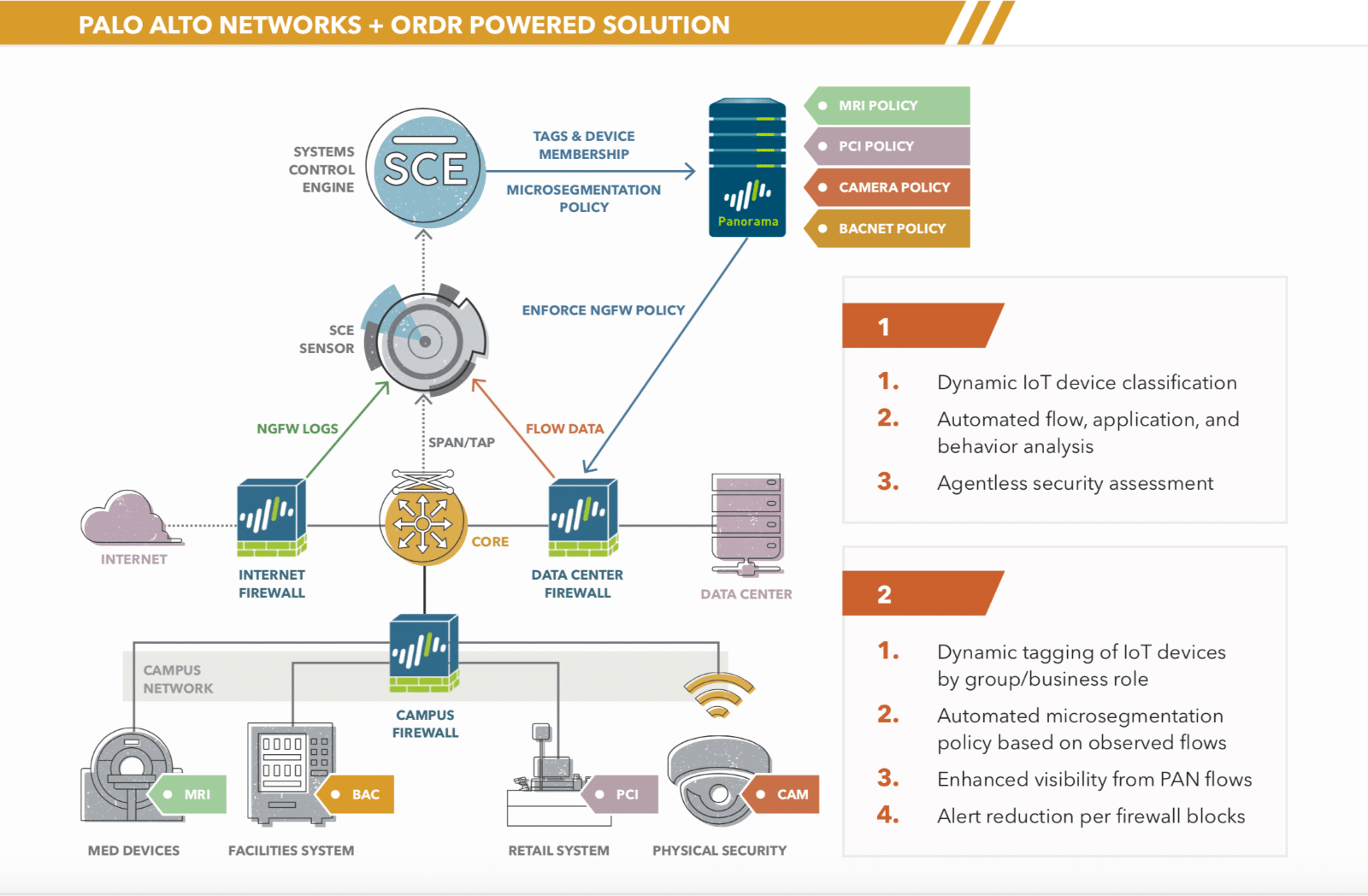
Philips
Ordr integrates with Philips Focal Point to gain additional insights for Philips devices managed by PerformanceBridge Focal Point.
Ping Identity
Enable Single Sign On (SSO) for Ordr with Ping Identity.
Pulsedive
Ordr integration with Pulsedive automates threat detection and risk assessment for external traffic from all connected devices. Ordr collects details on malicious URLs, IP addresses, and files from Pulsedive.
Qualys
Ordr’s bidirectional integration with Qualys enables comprehensive vulnerability scanning without gaps or disruptions. Qualys uses Ordr device insights to determine when and how devices are scanned and if they have been excluded. Ordr uses Qualys scan results in the calculation of device risk scores and other security analytics.
How it works
Ordr integrates with the Qualys Cloud Platform to seamlessly send device insights and enable organizations to identify devices to scan with the appropriate type of scan for each device. Ordr also incorporates Qualys scan results with security and risk analysis to calculate a risk score for every connected device for an accurate and comprehensive view of risk.
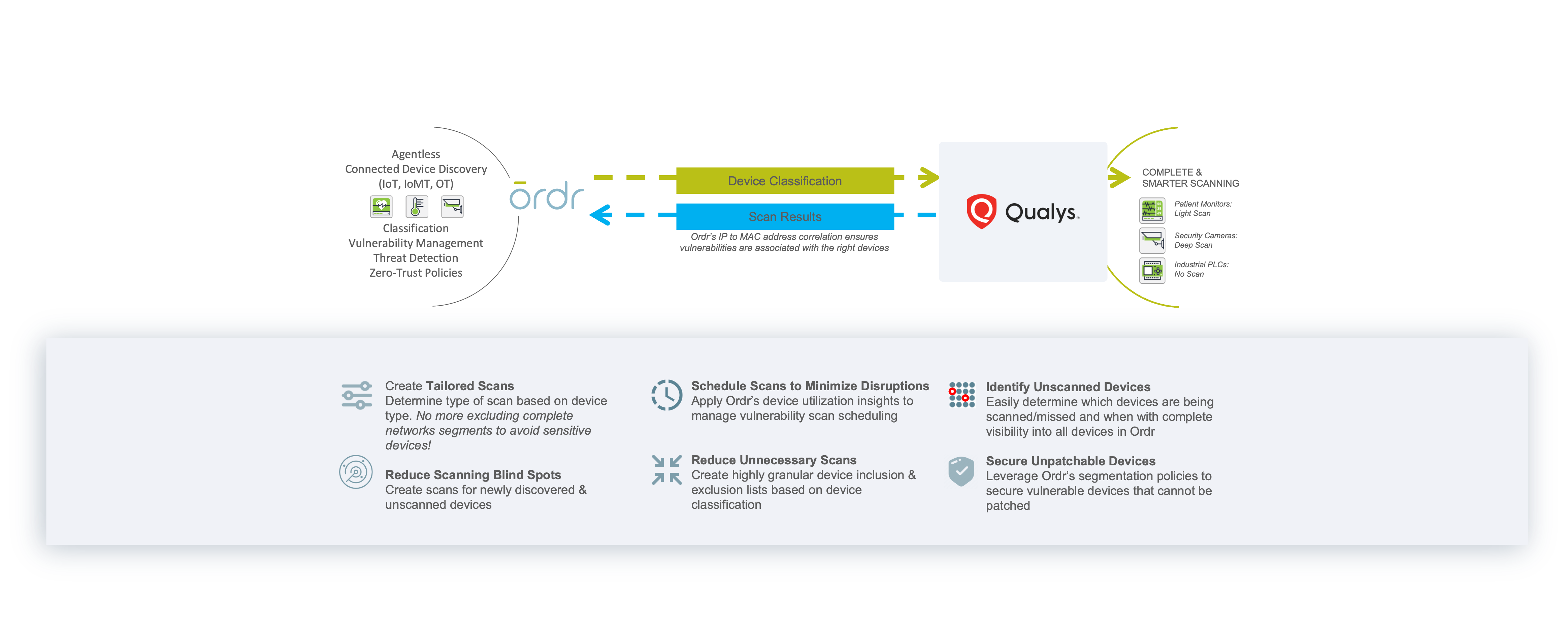
Benefits
- Comprehensive Coverage – Gain complete visibility of all devices with Ordr to easily determine which devices are scanned, which are missed, and when scanning occurred. Additionally, Ordr’s identification and classification of lightweight, agentless devices allows administrators to quickly exclude specific connected devices or device categories from active scans, opening network segments to vulnerability scanning that had previously been excluded.
- Optimized Scanning – Easily Identify devices to exclude and apply the right scan type for each device category using detailed Ordr insight on device types, scan sensitivity, and device role within the organization.
- Proactive Protection – Automate segmentation policies with Ordr and enforce with existing security and network infrastructure to secure vulnerable devices rather than block or quarantine critical devices that cannot be patched or updated.
- Smart Scheduling – Leverage device utilization patterns from Ordr to schedule vulnerability scans for times when devices are not in use to minimize disruption and operational risk
Rapid7
Ordr works with Rapid7 to seamlessly discover all connected assets including IoT, IoMT, and OT devices. The joint solution enables Rapid7 to perform the right scan at the right time regardless of the device type, location, criticality or role within the organization. Many vulnerable IoT/OT devices discovered by Rapid7 cannot be patched or updated. Ordr automates the application of compensating controls to safeguard these devices by sending protection policies directly to firewalls, switches, wireless, or NAC systems. Similarly, infected devices can be quickly isolated through existing network and security devices.
How It Works
The integration with Ordr and Rapid7 InsightVM provide ongoing bi-directional synchronization for managing vulnerabilities with rich device context. Ordr discovers every connected device, profiles device behaviors and risks, and automates remediation responses. Rapid7 InsightVM provides visibility into the vulnerabilities and clarity on how those vulnerabilities translate into business risk. Combining Ordr’s unique device intelligence with Rapid7’s advanced vulnerability intelligence provides organizations with the ultimate solution to efficiently manage risks while reducing service disruption and time to remediate.
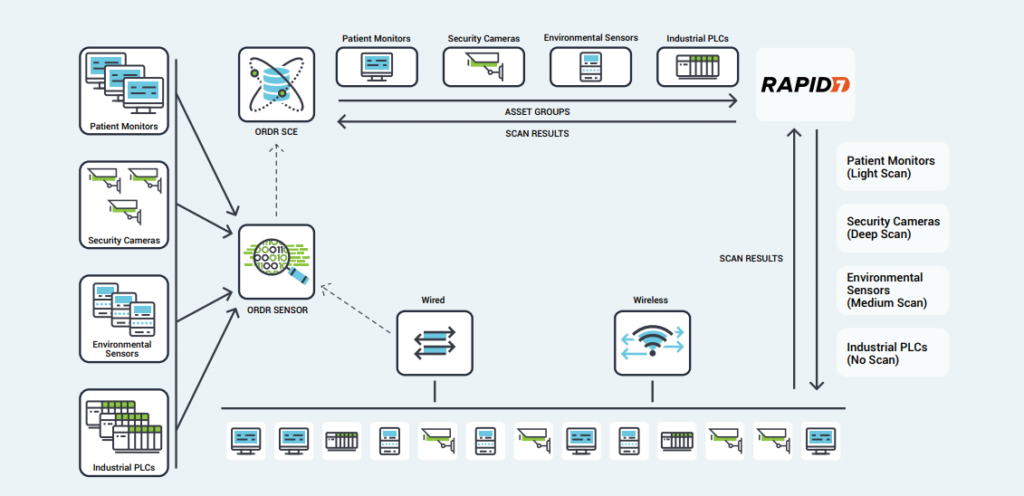
Benefits
- Comprehensive Coverage – Ordr’s identification and classification of lightweight, agentless devices allows administrators to quickly exclude specific IoT devices or categories from active Rapid7 scans, opening network segments to vulnerability scanning that had previously been excluded.
- Optimized Scanning – Using Ordr’s detailed insight into device types, scan sensitivity, and their critical role within the organization, Rapid7 scans can be tailored to each device.
- Proactive Protection – Rather than blocking or quarantining critical IoT devices after infection, Ordr’s segmentation policies create barriers that protect vulnerable devices while still enabling essential services.
- Smart Scheduling – Ordr tracks utilization patterns for critical devices, allowing administrators to schedule vulnerability scans for times when devices are not in use, minimizing disruption and operational risk.
Riverbed
Ordr integrates with Riverbed wired infrastructure to augment device profiles with network context, visualize communications and enforce policies.
Salesforce
Ordr integrates with Salesforce for additional user, usage and device context to deliver rich user insights.
SentinelOne
Ordr integration with SentinelOne enables collection of managed device data, vulnerabilities and threat insights for comprehensive device visibility and a better understanding of risk.
How It Works
Ordr discovers and secures every connected device—from traditional IT to new or vulnerable IoT, IoMT, and OT devices. With the SentinelOne integration, Ordr collects managed device data, vulnerabilities, and threat insights from the Singularity Platform delivering comprehensive device visibility, a better understanding of risk, and the ability to enforce policy to mitigate active threats and improve security across all connected devices.
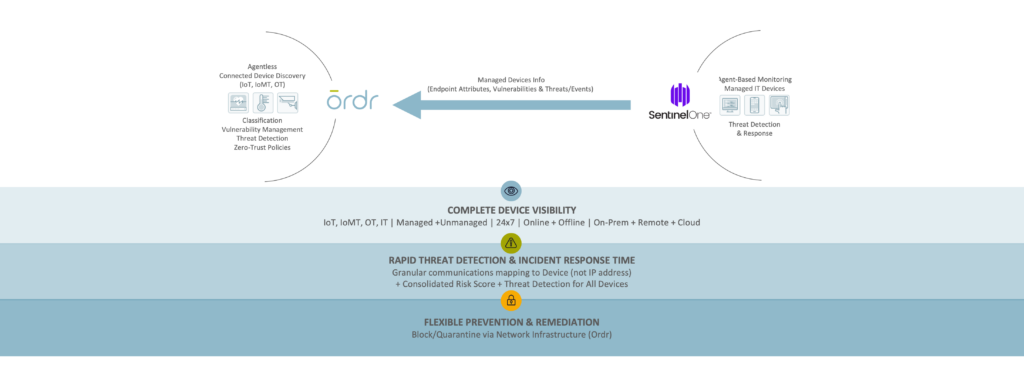
Benefits
Gain Complete Device Visibility
- See granular details for all agentless and agent-based devices.
- Track both online and offline devices continuously.
- Identify unmanaged devices without the SentinelOne agent to meet compliance requirements.
Minimize Risk with Extended Insights
- Improve risk score accuracy with supplemental event data from SentinelOne.
Remediate Faster
- Improve threat detection and incident response with combined Ordr endpoint flow and SentinelOne process data.
- Block/quarantine/segment managed endpoints in Ordr for rapid remediation via the network.
Slack
Ordr integrates with Slack to automate alert communications when a threat or incident is detected.
Sophos
Ordr integrates with Sophos XDR platform enabling organizations to leverage comprehensive device and risk insights for advanced threat detection and response.
Splunk
Ordr integration with Splunk allows you to leverage Ordr’s rich device data to create alerts, reports, and custom analyses. Ordr transmits security alerts, device information, and other critical information. Splunk ingests the feed for better event management.
Tanium
Ordr integrates with Tanium to provide comprehensive visibility across all agent-based and agentless devices, and risk insights for proactive risk mitigation.
Tenable
Ordr works with Tenable to seamlessly discover all connected assets including IoT, IoMT, and OT devices. The joint solution enables Tenable to perform the right scan at the right time regardless of the device type, location, criticality or role within the organization.
How It Works
Ordr automatically discovers and classifies all network connected devices and gathers granular context such as make, model,
hardware, OS, and software versions by passively analyzing network traffic with deep packet inspection. Ordr can then send
collected device details to a customer’s Tenable.io or Tenable.sc instance, providing these tools with a detailed understanding of
which assets to scan and the type of scan best suited to each device.
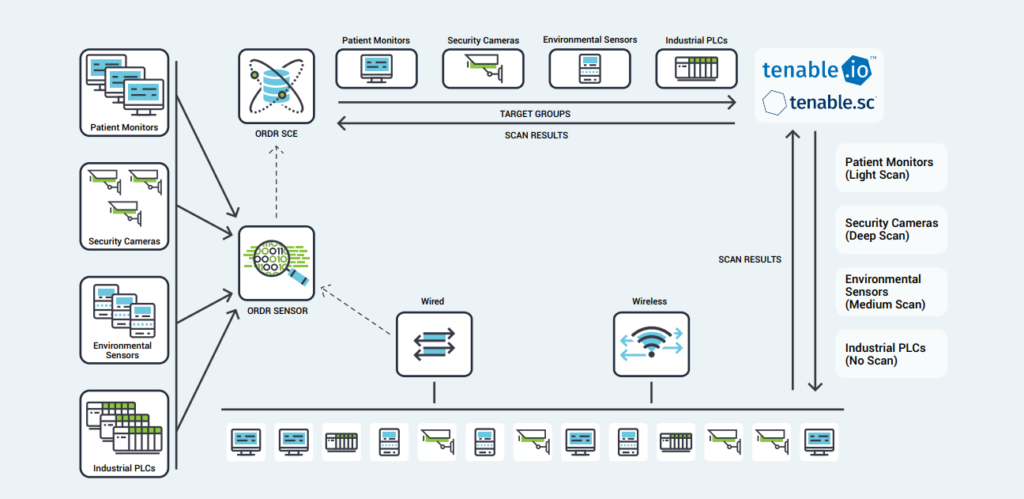
Benefits
- Comprehensive Coverage – Ordr’s identification and classification of lightweight, agentless devices allows administrators to quickly exclude specific IoT devices or categories from active Tenable scans, opening network segments to vulnerability scanning that had previously been excluded.
- Optimized Scanning – Using Ordr’s detailed insight into device types, scan sensitivity, and their critical role within the organization, Tenable scans can be tailored to each device.
- Proactive Protection – Rather than blocking or quarantining critical IoT devices after infection, Ordr’s segmentation policies create barriers that protect vulnerable devices while still enabling essential services.
- Smart Scheduling – Ordr tracks utilization patterns for critical devices, allowing administrators to schedule vulnerability scans for times when devices are not in use, minimizing disruption and operational risk.
ThreatConnect
Ordr integration with ThreatConnect allows you to leverage Ordr’s rich device data to create alerts, reports, and custom analyses. Ordr transmits security alerts, device information, and other critical information. ThreatConect ingests the feed, parses the data into proper fields for better event management.
VMware
Ordr leverages the vSphere API, which provides access to server management, virtual machine provisioning, monitoring, and more. Ordr collects datacenter asset details including the servers (hosts), individual virtual machines (guests), operating systems, shared compute resources (CPU, memory, disk), status, and compatibility.
The extended visibility to VMware workloads running in public, private, and hybrid cloud environments delivers a ‘whole hospital’ or ‘whole enterprise’ approach to security ensuring that no device or connection remains unknown.
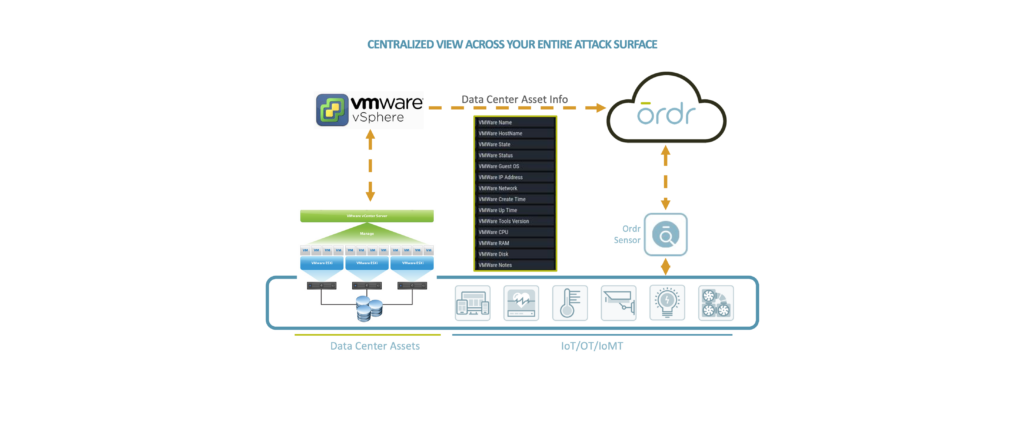
Zendesk
Ordr integrates with Zendesk to automate ticketing when a threat or incident is detected.
Zenefits
Ordr integrates with Zenefits for additional user context to deliver rich user insights.
Zoom
Ordr integrates with Zoom to capture additional user, usage and device context to deliver rich user insights.






